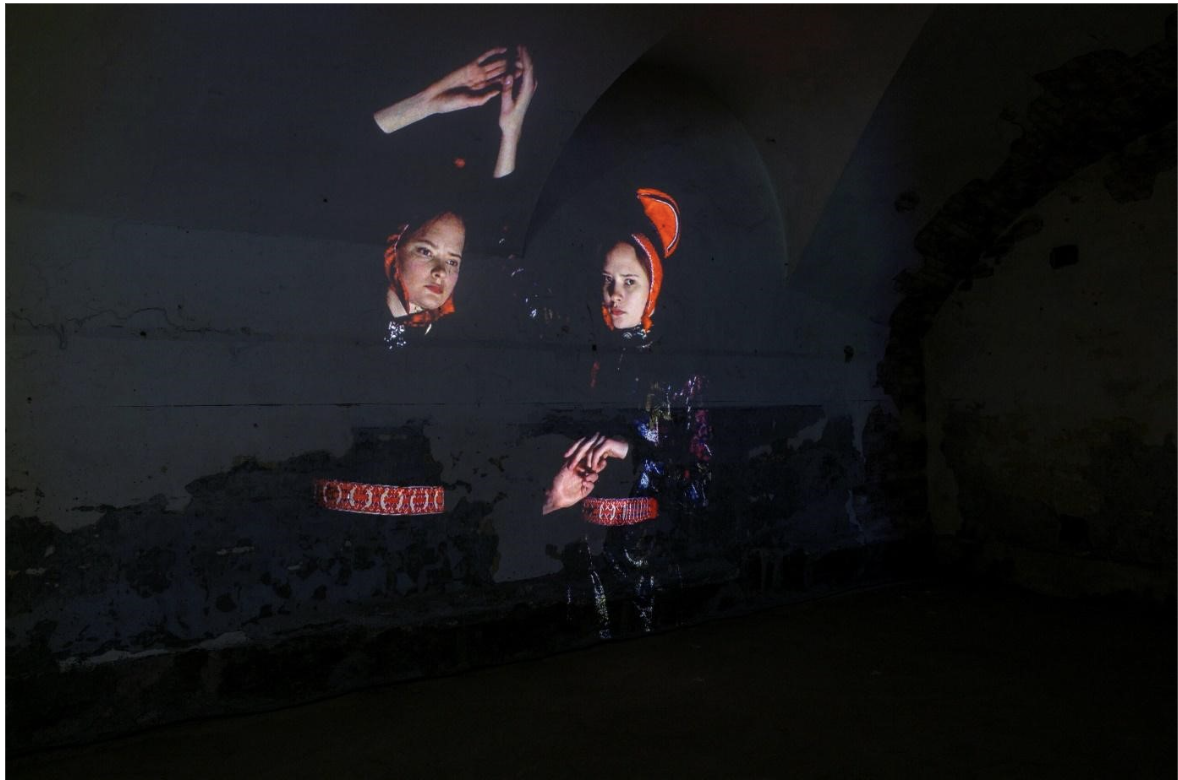Guhte gullá (Here to hear). Outi Pieski, Biret Haarla Pieski, Gáddjá Haarla Pieski. 2021. Multi-channel video installation. 8:30 minutes. RiddoDuottarMuseat. SD 1183. Photo: Maija Toivanen/HAM/Helsinki Biennal.
Guhte Gullá/Here to hear features young Sámi dancers within a dark room, which symbolizes the underground and represents an escape from the anxiety of modernity's destruction of the earth. Through their dance they seek guidance from the forgotten Sámi earth goddesses Uksáhkká, Juksáhkká, and Sáráhkká. The work expresses a deep connection to the earth and ancestors, emphasizing the need for all to restore a sacred connection to our natural environment.
This video installation highlights multi-generational strong Sámi women.The artwork is an artistic collaboration between the Sámi visual artist Outi Pieski and the featured dancers, her daughters Biret Haarla Pieski and Gáddjá Haarla Pieski. This collaboration incorporates traditional Sámi duodji – a North-Sámi word often reduced in a translation to ‘handicraft’ but incorporates the philosophy in which Sámi material culture and creative practices emerge. Duodji, alongside the dance and the traditional Sámi luohti (North-Sámi yoik), can be seen as a liberating ritual that creates a spiritual space which enables contact with the foremother’s wisdom. In this practice, previous generations are given a voice through the dancers. The work’s soundtrack consists of Tuomo Puranens electronic music and Mari Boine’s luohti, which invites the viewers to partake in a change by using all senses and listen to the foremother’s message.
A central element in their work is the ládjogahpir (hornhat), a traditional Sámi headwear worn by Biret and Gáddjá. The ládjogahpir symbolizes Sámi women and creates a sense of belonging, while resistance to its history, marked by oppression. During the 19th century, the ládjogahpir was nearly eradicated due to Christian missionaries’ claims that the horn was inhabited by the devil. However, due to modern institutional decolonizing projects like Bååstede (South-Sámi term for “coming back”) and the artistic agencies of Outi Pieski and her collaborators, the ládjogahpir and its philosophy has been revitalized. Today, the ládjogahpir crowns several Sámi women, symbolizing their empowerment and dignity.
The context of historical visual material created by colonial agents, connects to the paintings of François-Auguste Biard from the early 19th century. This visual material partook in ethnocentric discussions on race, civilization, and modernity – the forces that led to the loss of traditions passing from one generation to the next. Paradoxically, these discussions have become important sources for revitalization projects exemplified with institutional repatriation and artists agencies contributing to the specific headwear.
Guhte Gullá/Here to hear is more than a contemporary artwork that creates a counter-story to the narratives portrayed by non-Sámi in the historical sources. It is a powerful manifestation of Sámi culture, identity, philosophy, and resilience. The work demonstrates how contemporary Sámi artists in collaboration create a strong voice through visual (duodji), vocal (luohti) and hearing (dance) practices – reflecting the holistic Sámi worldview. Dance, being an English word points to a disconnection to Sámi tradition - maybe this is a forgotten tradition that the younger generation (Biret and Gáddjá) seeks to revitalize?
Essay by Ulrikke Marie Strandli
Directors: Biret Haarla Pieski, Gáddja Haarla Pieski & Outi Pieski
Cinematography: Mauri Lähdesmäki
Choreography: Biret Haarla Pieski & Gáddja Haarla Pieski
Performers: Biret Haarla Pieski & Gáddja Haarla Pieski
Music: Mari Boine & Tuomo Puranen
Editing: Mauri Lähdesmäki
Sound design: Pekka Aikio
Costume designer: Auri Lukkrarinen & Outi Pieski
Film assistant: Maria Duncker
Sound recording: Svein Schulz
Commissioned by HAM/Helsinki Biennial 2021
Further Reading:
Gaski, Harald. 1993. Med Ord Skal Tyvene Fordrives: Om Samenes Episk Poetiske Diktning. 1 utg., 2 oppl. ed. Karasjok: Davvi girji.
Gaski, Harald. 2022. “Words, Images and Sounds – Contemplating Sámi Readings, Interpretations and Understanding.” Čatnosat : The Sámi Pavilion, Indigenous Art, Knowledge and Sovereignty: 37-40. Edited by Katyja García-Antón, Liisa-Rávná Finbog and Niillas Beaska.Valiz. Amsterdam: Office for Contemporary Art Norway.
Harlin, Eeva-Kristiina, Outi Pieski, Gunvor Guttorm, Veli-Pekka Lehtola, Jan-Erik Lundström, Kaija Anttonen, et al. 2020. Ládjogahpir : Máttaráhkuid Gábagahpir = the Ládjogahpir : The Foremothers' Hat of Pride = the Ládjogahpir. The Ládjogahpir. Kárášjohka: Davvi girji.
Myrhaug, May-Lisbeth. 1997. "I Modergudinnens Fotspor: Samisk Religion Med Vekt På Kvinnelige Kultutøvere Og Gudinnekult." Oslo: Pax.
Pieski, Outi. 2021. “Guhte Gullá/Here to hear.” https://www.outipieski.com/installations-collages/guhte-gulla-here-to-hear/
